- About Us
- Columns
- Letters
- Cartoons
- The Udder Limits
- Archives
- Ezy Reading Archive
- 2024 Cud Archives
- 2023 Cud Archives
- 2022 Cud Archives
- 2021 Cud Archives
- 2020 Cud Archives
- 2015-2019
- 2010-2014
- 2004-2009
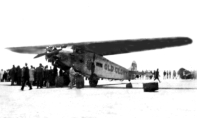 |
The Cud On History: Old Glory Wings to Glory from The Beach |
If Lloyd Bertaud had not successfully obtained a court injunction, he might never had visited Old Orchard Beach in Maine - nor vanished afterwards.
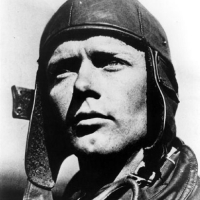
Charles Lindbergh
Throughout the early and mid-1920s, aviators repeatedly set and broke flying records, but non-stop transoceanic flights eluded completion. Aviation aficionado Raymond Orteig owned two New York City hotels: the Brevoort and Lafayette. In 1919 he had announced the Orteig Prize, which would award $25,000 to the first pilot — any nationality, the French Orteig declared — to successfully fly non-stop from NYC to Paris or Paris to NYC during the next five years.
No aviator even attempted the flight. Orteig renewed his five-year offer in 1926.
Believing that “modern” aircraft could handle a transatlantic flight, aviators raced for the Orteig Prize. Charles Lindbergh, then a young and yet experienced aviator who was well known in St. Louis, announced his intention to fly from NYC to Paris. Obtaining financial backing in St. Louis, Lindbergh traveled to New York to buy the “Columbia,” an aircraft that Giuseppe Bellanca had handcrafted for the Air Mail Service. Pilot Clarence Chamberlin had already kept the “Columbia” aloft for 51 hours, thus setting a world record. Lindbergh figured that if Chamberlin — then employed by the Columbia Aircraft Company — could stay airborne for 51 hours, then he could do so, too.
Lindbergh offered $15,000 (the asking price) for the plane. “Sure, I’ll sell it to you,” Columbia Aircraft Board Chairman Charles Levine told Lindbergh in paraphrase, “but I get to pick the pilot, and it ain’t you, Lindy baby. I want Chamberlin.”
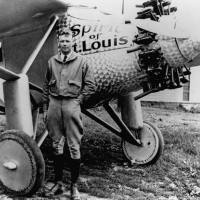 “No deal,” Lindbergh probably replied before departing NYC. Then, in February 1927, Ryan Airlines President Frank Mahoney contacted Lindbergh and offered to build him a high-wing monoplane. Lindbergh met in San Diego with Mahoney and Donald Hall, an aircraft designer. The three men developed a unique design that became the Ryan M-2, dubbed the “Spirit of St. Louis” by Lindbergh.
“No deal,” Lindbergh probably replied before departing NYC. Then, in February 1927, Ryan Airlines President Frank Mahoney contacted Lindbergh and offered to build him a high-wing monoplane. Lindbergh met in San Diego with Mahoney and Donald Hall, an aircraft designer. The three men developed a unique design that became the Ryan M-2, dubbed the “Spirit of St. Louis” by Lindbergh.
Ryan Airlines completed the plane on April 28, 1927. Taking off from Curtis Field in New York and clearing telephone wires by only 20 feet, Lindbergh and the “Spirit of St. Louis” flew into history on May 20, 1927.
Two French aviators almost beat “Lucky Lindy” to win the Orteig Prize. Only twelve days before Lindbergh launched his famous flight, French aviators Charles Nungesser and Francois Coli settled into their seats aboard a PL-8 biplane and took off from Le Bourget Field near Paris to fly to New York City. Dubbed “L’Oiseau Blanc” (White Bird) for its Nungesser-inspired paint scheme, the PL-8 crossed the French coast at Normandy and promptly vanished.
North Atlantic weather proved particularly nasty that May; if they did reach the Canadian or American coastlines, Nungesser and Coli apparently became lost, and L’Oiseau Blanc burned all her fuel. Persistent rumors about a plane heard flying through decrepit weather over the Maritimes and Maine in May 1927 would spur several intensive ground searches for L’Oiseau Blanc wreckage in Maine during the 1990s.
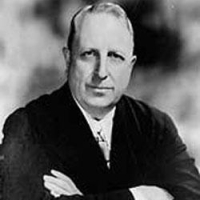
William Randolph Hearst
Meanwhile, in April 1927, newspaper magnate William Randolph Hearst indicated that he would sponsor a plane and crew to capture the Orteig Prize. Giuseppe Bellanca immediately indicated his intention to fly the “Columbia” from NYC to Paris. Bellanca tapped as his pilot Clarence Chamberlin, who asked airmail pilot Lloyd Bertaud to fly with him.
Charles Levine, whose Columbia Aircraft Company still owned the “Columbia,” tried to yank Bertaud, who obtained a court injunction to bar the “Columbia” from flying without him. Subsequent legal and emotional wrangling saw Levine successfully remove Bertaud from the crew and Bellanca resign his designer’s post with Columbia Aircraft. Intent on flying with Chamberlin, Levine boarded the “Columbia” before the plane took off on June 4, 1927.
Pilots and plane flew non-stop to Berlin, landing there 46-1/2 hours later.
Once tossed from the “Columbia,” Bertaud decided to stage his own transatlantic flight. He contacted his friend, pilot James DeWitt Hill, about flying with him from New York City to Rome.
Hill hailed from Scottdale, Pennsylvania. While a youth, he developed an intense interest in aviation, culminating in a failed parachute jump — with the family’s best tablecloth doubling as the parachute — from a stable. He later became a pilot circa 1913 and signed on with the Air Mail Service in July 1924.
In June 1927, Hill asked Bellanca to design a plane for the Rome flight. Bellanca indicated that this endeavor, from design through construction, would take several months — which was much too long, Bertaud and Hill decided.
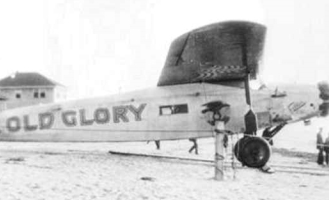 William Randolph Hearst agreed to sponsor their flight aboard an existing aircraft. Hearst remained “behind the scenes” during the subsequent run-up to an August-September launch; he let Philip Payne, editor of the Hearst-owned New York Daily News, serve as sponsorship spokesman.
William Randolph Hearst agreed to sponsor their flight aboard an existing aircraft. Hearst remained “behind the scenes” during the subsequent run-up to an August-September launch; he let Philip Payne, editor of the Hearst-owned New York Daily News, serve as sponsorship spokesman.
Hearst purchased a Fokker monoplane, a single-engine and high-wing aircraft with an enclosed, silver-painted fuselage; this plane, as clearly revealed in photographs owned by the Maine Aviation Historical Society, was the forerunner for the famous Fokker Tri-Motor. Hearst had the plane shipped from Germany and a separate motor from Britain.
Test pilot Brent Balchen made the maiden flight on Hearst’s “Old Glory” on July 30, 1927. Bertaud and Hill wanted to launch from NYC’s Roosevelt Field ASAP, but various factors pushed them to transfer the launch site to Old Orchard Beach, Maine. Payne accompanied Hill when he flew “Old Glory” to Maine and touched down on the Old Orchard sands on September 3.
Why the choice of Old Orchard Beach? Already famous as a summer resort, “The Beach” offered hard-packed sand suitable as a landing strip for the era’s lightweight aircraft. In fact, while flying his “Spirit of St. Louis” from France to United States in June 1927, Lindbergh had staged an unscheduled landing at Old Orchard Beach. Bertaud and Hill figured their heavy “Old Glory” would have sufficient distance to get airborne at The Beach.
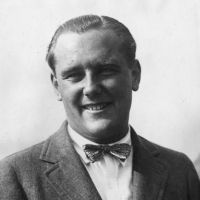
Lloyd Bertaud
Meanwhile, William Randolph Hearst grew doubtful about the flight. He repeatedly urged Payne to cancel the mission or at least stay home. Payne politely disobeyed his publisher’s orders.
At 12:23 p.m., Eastern Standard Time, the extremely heavy (at 12,700 pounds) “Old Glory” lifted off from Old Orchard Beach. Hill actually flew the plane, with Bertaud working the radio. Twelve motorcycle policemen briefly escorted “Old Glory” as she started taxiing; minutes later, the aircraft gingerly bounced from the Old Orchard sands, just missed the dance pavilion on the OOB pier, and buzzed north along the Maine coast.
Flying about 100 miles an hour, “Old Glory” slowly progressed across the Gulf of Maine, Nova Scotia, and Newfoundland. Eyewitnesses almost unanimously reported that the plane was flying low, a factor possibly indicative of the aircraft’s weight. Flashing the Morse Code call sign “WRHP,” Bertaud signaled various monitoring stations en route. At 2:55 p.m., Bertaud flashed a signal that plane and crew were doing well. Another signal at 3:55 p.m. acknowledged the aircraft’s heaviness. At 11:57 p.m. (EST), crewmembers aboard the S.S. California spotted “Old Glory” flying overhead 350 miles east of Newfoundland.
One legend affiliated with this flight has Payne bringing along a wreath adorned with a ribbon that read, “Nungesser and Coli: You showed the way. We followed. Bertaud and Payne and Hill.” Payne allegedly intended to drop the wreath somewhere over the Atlantic Ocean to pay tribute to the missing French aviators.
If this legend is actually fact, then Payne personally delivered the wreath.
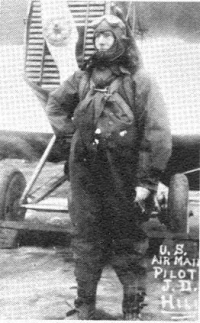
James DeWitt Hill
Suddenly, at 3:57 a.m. (EST), September 7, Bertaud signaled an SOS. He sent another SOS at 4:03 a.m. (EST), a signal received by the S.S. Transylvania. Calculating that his ship was only 65 miles (or so) from where the SOS originated, Captain David Bone set course and poured on all available steam to reach the stricken “Old Glory.”
Struggling in strong winds and high seas, the Transylvania and four other ships scoured the area for more than thirty hours. Finding neither wreckage nor survivors, the ship's crews abandoned the search.
William Randolph Heart promptly chartered the S.S. Kyle to find “Old Glory.” The Kyle’s crew did not take long; on September 12, they signaled that they had located sufficient wreckage — three fuel tanks, assorted fuselage components, and 34 feet from the wing — to identify the plane as “down for the count.” No survivors were found, however. The S.S. Kyle ferried the wreckage to St. John’s, Newfoundland, from where Hearst had the debris shipped to New York.
Bertaud, Hill, and Payne vanished into aviation history. So did several other transatlantic aviators during that same timeframe, including one aviatrix briefly affiliated with Old Orchard Beach:
- Headed for Ottawa, Royal Air Force pilots Leslie Hamilton and Fred Minchin took off from England on August 31, 1927 aboard the “St. Raphael,” another Fokker monoplane. Accompanying the flight was Princess Anne Lowestein-Wertheim, an aviation fan. The plane flew above an oil tanker near Newfoundland and then vanished in the fog. No wreckage was ever found.
- Frances Grayson, a married New York real estate tycoon, was a famed aviatrix who sought fame
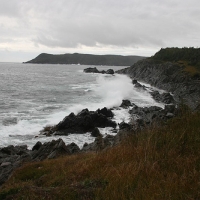 as the first woman to cross the Atlantic Ocean. She and a wealthy friend, a Danish woman, purchased the “Dawn,” a twin-engine aircraft, which Grayson brought to Old Orchard Beach prior to attempting a flight to Copenhagen. A savage storm damaged the plane at OOB, and when Grayson and pilot Wilmer Stutlz finally took off, engine trouble forced them to abort their flight soon afterwards.
as the first woman to cross the Atlantic Ocean. She and a wealthy friend, a Danish woman, purchased the “Dawn,” a twin-engine aircraft, which Grayson brought to Old Orchard Beach prior to attempting a flight to Copenhagen. A savage storm damaged the plane at OOB, and when Grayson and pilot Wilmer Stutlz finally took off, engine trouble forced them to abort their flight soon afterwards.
Grayson did not take the repeated hints. In December 1927, she and pilot Oskar Omdal took off aboard the “Dawn” from Roosevelt Field, destination Denmark. Aircraft and crew promptly vanished.
